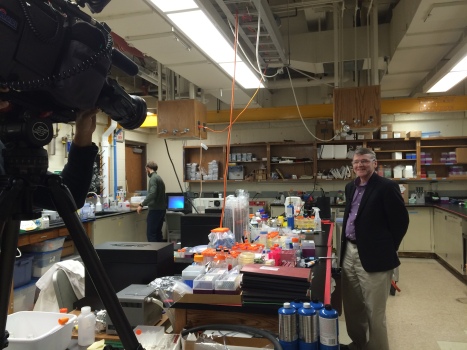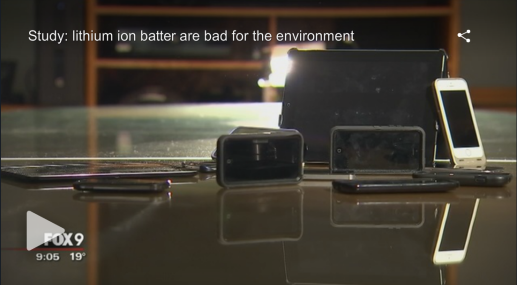Last Thursday, the Center for Sustainable Nanotechnology had a brush with mainstream media exposure: A Twin Cities TV station, KMSP: Fox 9, did a story about a recent CSN publication for the 9 o’clock news! The opportunity to get such broad public exposure for our research was really exciting.

In the case of Thursday’s TV story, it started because the CSN recently had a paper accepted to the journal Chemistry of Materials.1 The study showed some negative effects of a nanomaterial called NMC (nickel magnesium cobalt oxide) on population growth and respiration of one type of bacteria, Shewanella oneidensis. The findings are important partly because NMC is a component in one type of lithium ion battery that is already widely used in electric cars like the Nissan Leaf, and is likely to become more widespread in the future. Lithium ion batteries in general are literally everywhere – cell phones, laptops, tablets, etc. – but most of those aren’t the kind with NMC nanomaterials.

That whole explanation is a bit much to squeeze into a headline, so Thursday morning’s press release about the paper is just titled, “Lithium battery component found to harm key soil microorganism.” So far so good. Then the first paragraph begins, “The material at the heart of the lithium ion batteries that power electric vehicles, laptop computers and smartphones has been shown to impair a key soil bacterium, according to new research published online in the journal Chemistry of Materials.” It’s a great hook to help the reader understand how ubiquitous lithium ion batteries are, and the next couple of paragraphs go on to explain more about how NMC is an emerging battery material, and why research into its effects on Shewanella oneidensis is important. Unfortunately, if you only read that first paragraph, you might come away thinking that the study was about your very own laptop battery being toxic to the environment… That might or might not be the case, but it’s not what this study was about.
The press release, also shared by the University of Minnesota, did its job: it attracted some attention from our local news media! Fox 9 News contacted the CSN’s Associate Director, U of MN Professor Christy Haynes, and they set up an interview for that afternoon. The reporter, Iris Perez, along with camera operator Justin McCray, were professional, friendly, engaged, and thorough in learning about the study. They interviewed Christy, graduate student Ian Gunsolus (co-first author on the paper along with UW-Madison student Mimi Hang), and CSN Director Bob Hamers, who happened to be visiting from Madison. Iris talked with each of them about what the study was about and why it was important, and then she asked two particular questions of all three interviewees:
- Which cell phones and laptops actually have this material in them?
- What do you recommend our viewers, or consumers in general, should do based on the results of this study?
For me, watching from the sidelines, those two questions stood out as important specifically for a TV audience: Why is this story relevant to us right now, and what can we do about it? (I don’t mean that critically at all – they were very reasonable questions to ask in this context – it just brought home for me the challenge of conveying any scientific nuance in the short, quick format of a TV news story.)

For the first question, Christy, Ian, and Bob all explained about how the NMC nanomaterials from the study are mostly found in electric car batteries and not cell phones or laptops, but because NMC is cheaper than some alternatives it is likely to start being used in other consumer electronics soon. For the second question, Ian mentioned that there needs to be more economic incentive for recycling battery materials, and viewers could contact their legislative representatives to advocate for those incentives. All three confirmed that, regardless of whether a product has NMC or some other type of lithium-ion battery, it is very important to recycle it in order to keep battery materials from contaminating the environment.

We only realized later how that first paragraph of the press release could have led to the misconception that NMC is currently widespread in cellphone and laptop batteries. We wondered if the news segment might end up saying something sensational like, “Study shows your cell phone battery is deadly!!!”
Gathered around the TV at precisely 9:04 that night, we were slightly concerned when we saw the headline:

The purpose of our study was not to demonstrate that lithium ion batteries are “bad,” but rather to understand potential environmental impacts of emerging nanotechnologies so that we can improve their design.
It turns out we needn’t have worried! As you can see from the full video below, although the headlines are a bit alarmist from a scientific perspective, the story itself does a good job of capturing the key points of the study and making it relevant to viewers.

The experience was an interesting reminder of the very different communication styles used in research versus TV news. When scientists communicate with each other by publishing in scientific journals, precision and accuracy in their language is highly prized. Exaggerating results or leaving out details can give the wrong impression, and is therefore frowned upon. Academic papers often represent months or years of work, and include very technical titles like the paper that was the focus of all this great press: “Impact of Nanoscale Lithium Nickel Manganese Cobalt Oxide (NMC) on the Bacterium Shewanella oneidensis.”1
TV news, on the other hand, needs to report what happened today, and how a story will affect you, the viewer, right now. Equally important in the 24/7 news cycle is “Why should you keep watching after the commercial?” A news story may have three minutes to explain an event that just occurred a few hours ago. With academic papers, not only do they come out months after discoveries are made; sometimes years go by before the significance of the research is fully apparent.
NPR Science Correspondent Joe Palca has talked about how difficult it is to “stop trying to pretend that science is news in the same way politics or crime or sports are news.” As he wrote in a piece on The Open Notebook last fall, “It’s easy to say what will make news in crime or sports. But science is different. Deciding what’s important enough to report on is tricky.”2
University communications offices are aware of this conundrum, and have the unenviable task of coming up with press releases that will attract the attention of media outlets. It’s not just that we all want to be on TV, though that can be kind of cool; as scientists, we want to make sure the public has access to the results of our work. This is especially important when we are funded through public money, like our CSN grant from the National Science Foundation. So even though everyone might agree that the Center’s research is cool and interesting and maybe even of global importance… it can be hard to explain why it’s news.
I now have a new appreciation for how hard the cross-cultural communication can be between scientists and mainstream media. We all want to explain the research and help our audience understand what it means and why it’s important. The challenge comes because we work with very different audiences and different assumptions about what the important aspects of the message are.
It’s possible that after the quick three minutes of Thursday’s news clip, viewers might still be confused about whether the CSN study was about the batteries in their cellphones, and they might not catch that there were nanoparticles involved, or exactly why Shewanella oneidensis was used in the study. But I think that’s okay. I think the audience will probably get the idea that our scientists are working on understanding how battery materials affect the environment, that they’re trying to make those materials safer, and that batteries should be recycled! Although those aren’t the outcomes a scientific article would aim for, for a TV news communication it’s exactly what we want.
- Hang, M., Gunsolus, I., Wayland, H., Melby, E., Mensch, A., Hurley, K., Pedersen, J., Haynes, C., & Hamers, R. Impact of Nanoscale Lithium Nickel Manganese Cobalt Oxide (NMC) on the Bacterium Shewanella oneidensis MR-1. Chemistry of Materials, 2016, Just Accepted. doi: 1021/acs.chemmater.5b04505
- Palca, J. A Day in the Life of Joe Palca. The Open Notebook [blog]. Sept 22, 2015. Retrieved from http://www.theopennotebook.com/2015/09/22/a-day-in-the-life-of-joe-palca/

[…] in learning more about the study on NMC nanomaterials and bacteria that was discussed in Monday’s post? We’ve had two more opportunities to discuss this Center for Sustainable Nanotechnology […]